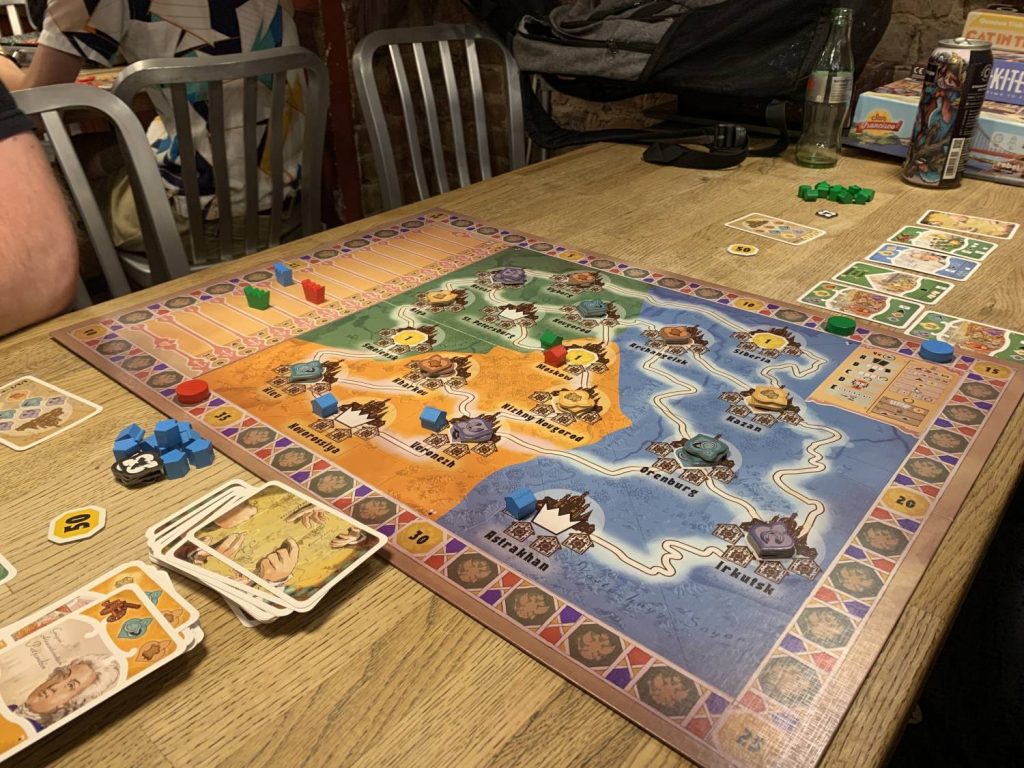Disclosure: Meeple Mountain received a free copy of this product in exchange for an honest, unbiased review. This review is not intended to be an endorsement.
From the moment I first saw an ad for Catherine: The Cities of the Tsarina, I was interested. The look of the thing, a map full of connected cities with a color palette that suggests beige even if it isn’t actually particularly beige, promised the sort of good old fashioned gaming experience you get with titles like El Grande and Hansa Teutonica. What could go wrong?
A remarkably simple game to teach in person, Catherine is a remarkably complicated one to teach via prose. Over the course of a round, or “Decade” as the game calls them, you will play cards to two imaginary rows. The upper of these two rows is your Action Row, which is to say it is the row with cards whose icons and actions you want to use. The lower of these two rows is your Activation Row. The cards played to the Activation Row have no function or purpose other than to activate—go figure—one of the cards in your Action Row.

Each turn, all players simultaneously play two cards from their hand, one to their Action Row and one to their Activation Row. You start each Decade with three Action Cards already on the table, and each Action Card is played to the immediate right of the previous one. The Activation Card can be played beneath any Action Card that hasn’t already been activated.
What you’re trying to do with your activation cards is match suits. An orange card played beneath a blue card won’t do anything, but an orange card played beneath another orange card will allow that player to execute the card’s action and bonus, if it has one.
While initially it seems like there are dozens of actions, there are really only a few, each coming in several mild variations. Fundamentally, you’ll draw cards, score points outright, add houses to cities on the board, or move up the Influence Track.
Oh, I suppose I haven’t mentioned the theme yet. Why would there be an Influence Track? You’re competing to be Catherine the Great’s most trusted and influential advisor. Just as well that I forgot to mention it, because the gameplay does n o t h i n g to evoke it. I don’t necessarily find that to be a grave sin. El Grande and Hansa Teutonica don’t evoke much of a theme either and you’ll never once hear me complain. They remembered to include exciting gameplay, though. Catherine, not so much.

At the end of each Decade, there’s some inter-round scoring and each player resets their tableau so the three cards in the Action Row without Activation Cards underneath are all that’s left. You’ll complete three Decades and then do final scoring.
Here’s What I Like About Catherine: The Cities of the Tsarina:
- It’s short, and I don’t mean that as a backhanded compliment. The box says 30-45 minutes and a full game can easily be done in 30. If you played this a bunch, you could probably get a full two-player game done in 20-25 minutes without breaking a sweat.
Here’s What I Don’t Like About Catherine: The Cities of the Tsarina:
- It’s just not very interesting. I don’t know what to tell you. I can’t explain it. Like, it’s fine! There’s nothing wrong with it. If I had to prove in a court of law that it’s not a particularly good game, I couldn’t do it, but it isn’t.
- There’s some arbitrary player interaction around having the most cannon and book icons in your Action Row at the end of each Decade, but there might as well not be other players at the table.
- You have twelve actions over the course of this game, and those twelve actions are sufficient to accomplish most of the things. You can get the majority of your residences out on the board and get pretty high up the Influence Track and get a respectable number of goods for your order card (don’t worry about it) and you might feel a little pressure on, like, your last two card plays at most but otherwise it just kinda happens.
- There are no surprises. I didn’t learn a single thing during my first game that I could carry over into my second, and I definitely didn’t learn a single thing during my second that I could carry over into my third. That’s probably my biggest problem with it. It’s perfectly respectable as a design but there’s nothing to explore. You play it once and you’ve played it to the best of the game’s abilities. Who wants that?

In Conclusion
Catherine has been getting spammed by BGG users from Ukraine giving it 1’s because of the theme. I understand the anger; a board that depicts Kyiv as part of Russia is going to strike a particularly raw nerve at the moment. Capstone Games wouldn’t have known when they started developing this game that there would be a major military conflict between Russia and Ukraine by the publication date, of course, but I don’t need to tread into that.
I’ll say this: As I’ve referenced more than once, BGG scores for big releases from major publishers always end up between a 7.1 and a 7.4, no matter how poor they are. The spammers have had such an outsized effect on Catherine: The Cities of the Tsarina that it’s just about the only fair-to-middling game on BGG to have the score I think it deserves: As of this writing, it sits at 5.4: Mediocre – Take It or Leave It.












Add Comment